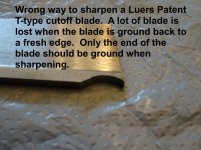Flute Maker
Cast Iron
- Joined
- Feb 17, 2007
- Location
- Needham, MA
Gentleman, et al,
I just found what I guess is an Empire cut-off holder in a box of stuff. AX18, A36. Works great. Fits in when you have a tight fit between the turret and collet. Another thread brought me to Crobalt® :: Cut-Off Blades
My question is can I use the 3/32" x .476" Tan 2000, as well as the 1/8" x .476" Tan 2002 tools in the same holder?
Thanks so much,
Payson.
I just found what I guess is an Empire cut-off holder in a box of stuff. AX18, A36. Works great. Fits in when you have a tight fit between the turret and collet. Another thread brought me to Crobalt® :: Cut-Off Blades
My question is can I use the 3/32" x .476" Tan 2000, as well as the 1/8" x .476" Tan 2002 tools in the same holder?
Thanks so much,
Payson.







